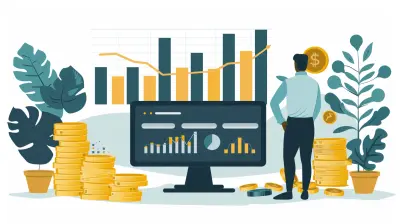How Real Estate Markets Are Linked to Interest Rate Movements
22 July 2025
Ever wondered why people panic (or cheer) when the Federal Reserve announces an interest rate change? Especially if you’re dabbling in real estate or planning to buy a home, those rates matter—a lot. But how exactly are the real estate markets tied to interest rate movements? Let’s break it down in plain English, and by the end of this deep dive, you’ll have a solid grasp on how the two perform their delicate dance.

Why Interest Rates Matter More Than You Think
Let’s start with a simple truth: money isn’t free. Most of us don’t fork over a suitcase of cash to buy a house—we borrow. And when we borrow, we pay interest. So when interest rates go up, borrowing becomes more expensive. When they go down, it's cheaper to borrow. Sounds basic, right? But the ripple effects on the real estate world are anything but small.Imagine interest rates as the thermostat of the economy. Turn the heat up (raise rates), and things slow down. Turn it down (lower rates), and the market heats up. That’s exactly what happens with property buying, selling, and investing.

The Relationship: Where Real Estate Meets Interest Rates
1. 🏡 Mortgage Rates: The Frontline Impact
When the Fed adjusts interest rates, it doesn’t directly set mortgage rates—but it sure does influence them. Mortgage lenders take cues from the Federal Funds Rate. As a result, higher interest rates typically push mortgage rates up, making monthly payments steeper.Let’s say you’re eyeing a cute three-bedroom home. At a 3% mortgage rate, your monthly payment might be manageable. But at 6%? You might suddenly find that cute home out of your budget. Many buyers back off, and demand cools down.
2. 💸 Home Affordability: The Domino Effect
In real estate, affordability is king. And interest rates directly impact how “affordable” a home really is. Even a 1% increase in rates can add hundreds of dollars to your monthly payments. That can mean the difference between locking in your dream home and delaying your homeownership goals.Fewer buyers = less demand.
Less demand = falling (or stabilizing) home prices.
It’s a domino effect that starts with tiny numbers and ends in major market shifts.
3. 📉 Home Prices Don’t Like High Rates
Let’s get real—high interest rates often lead to downward pressure on home prices. When buyers disappear because borrowing is pricey, sellers are forced to rethink their asking prices. This tends to level out those sky-high price tags we see during housing booms.Is it good news? Well, if you’re buying with cash or a big down payment, yes! You might snap up a bargain while others sit on the sidelines.
4. 🏦 Investor Behavior: Playing Offense and Defense
Real estate investors are a savvy bunch. They watch interest rate movements like hawks. When rates rise, returns on rental or flipped properties can shrink. That’s because higher financing costs eat into profits.But wait—investors don’t just retreat quietly. Sometimes, they pivot. For example, in rising rate environments, more folks rent instead of buy. Smart investors catch this trend and beef up their rental property portfolios.
It’s like a chess game. Every rate change is a move worth analyzing.

Long-Term vs. Short-Term Rates: What’s the Difference?
Here’s where it gets a bit technical, but stay with me. There are short-term interest rates (like the ones the Fed directly controls), and long-term rates (like 10-year Treasury yields that heavily influence mortgage rates).Sometimes, short-term rates go up, but long-term rates lag behind. This can create temporary market conditions where fixed long-term mortgage rates don’t spike as much as you’d think. Real estate reacts mostly to long-term rates.
Think of it like driving up a hill. The steepness (interest rate) affects how much gas (money) you need. But whether the hill is a short bump or a long incline changes your strategy entirely.

The Fed’s Role: Pulling the Strings Behind the Curtain
You’ve probably heard “The Fed raised interest rates today” during news broadcasts. But who are these people, and why do they get to decide?The Federal Reserve, aka “The Fed,” controls the base interest rate to keep inflation and employment in check. If inflation’s too high, they raise rates to cool spending. If the economy’s slow, they cut rates to spark activity.
Real estate is one of the first sectors to respond to these changes. It’s kind of like a canary in the coal mine—showing early signs of cooling or overheating.
Historical Perspective: Been There, Done That
Let’s time-travel. Remember the 1980s? Interest rates were ridiculously high—think mortgage rates of 15-18%. Home sales cratered, and affordability hit rock bottom.Then look at the early 2000s. Interest rates were slashed after the dot-com bubble burst, and the real estate market soared. That boom eventually led right into the 2008 housing crash. Why? Easy credit led to risky lending. When rates adjusted, the house of cards collapsed.
Fast forward to the pandemic. Interest rates were slashed again, hitting record lows. Everyone and their cousin wanted a home. Demand exploded. Prices skyrocketed. But when inflation reared its head again, interest rates jumped back up—and guess what? Buyers hit the brakes.
History doesn’t lie. Each cycle shows how sensitive real estate is to interest rate tweaks.
Interest Rate Changes: Threat or Opportunity?
It all depends on your goals.- Are you a first-time buyer looking for a long-term home? Lower rates can help you afford more.
- Are you an investor seeking cash flow? Rising rates might squeeze your margins but increase rental demand.
- Are you refinancing? Timing is everything. Lock in those rates when they’re low.
Instead of fearing rate hikes, savvy players pivot their strategies. It’s not about predicting the market—it’s about positioning yourself smartly within it.
Global Perspective: It’s Not Just a U.S. Thing
Real estate around the globe reacts similarly to interest rates. Whether it’s London, Vancouver, Mumbai, or Sydney, when central banks adjust rates, markets shift.In fact, international investors often look at interest rate differentials (the gap between rates in different countries) before deciding where to park their capital. If the U.S. offers better returns on properties while keeping rates steady, foreign money flows in. That increases demand and can boost prices even further.
Tips for Navigating the Market in a Changing Rate Environment
Let’s be practical. Rates will always change, but your financial mindset can be rock solid. Here are some grounded tips:✅ 1. Lock In a Fixed Rate Early
If you’re planning to buy, consider locking in a fixed mortgage when rates are low. That way, you’re protected from future hikes.✅ 2. Run the Numbers
Use mortgage calculators. Run scenarios. Know how a 1–2% rate increase impacts your budget. It’ll keep you prepared and avoid unrealistic expectations.✅ 3. Think Long-Term
Short-term rate spikes feel dramatic, but real estate is a long game. Don’t panic sell or rush into a bad deal just because of a rate change.✅ 4. Stay Informed
Follow the Fed, track inflation, keep an eye on job reports—they all affect interest rates. You don’t need to be an economist, but knowing the basics gives you an edge.✅ 5. Diversify Your Real Estate Strategy
Instead of solely relying on appreciation, consider buying rental properties in high-demand areas. Even if prices drop, rental demand (especially during high-rate periods) might increase.Final Thoughts: Control What You Can
Let’s face it—you can’t control the Fed. You can’t predict the next rate hike. But you can control your knowledge, preparation, and timing.Interest rates are just one lever in the complex machine that is real estate. Learn how they work, and instead of fearing them, you can leverage them to make smarter, more confident decisions.
Remember, real estate is part numbers, part timing, part gut instinct—and all about mindset. Stay curious. Stay adaptable. Stay in the game.
all images in this post were generated using AI tools
Category:
Interest RatesAuthor:

Zavier Larsen
Discussion
rate this article
1 comments
Niko Cole
Ah, the dance of real estate and interest rates! It’s like a chaotic tango where one partner steps on toes while the other adjusts their mortgage. Just remember: when rates rise, sellers sweat, and buyers suddenly become experts in negotiation. Who knew finance could be so... entertaining?
August 2, 2025 at 3:45 AM

Zavier Larsen
Absolutely! It’s a complex dance that keeps everyone on their toes—literally and financially! Thanks for the insightful comment!


